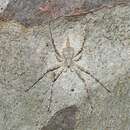en
names in breadcrumbs


The essentially tropical and subtropical spider family Hersiliidae (two-tailed or longspinneret spiders) includes 176 described species (Platnick 2013), just two of which occur in North America north of Mexico, both of them poorly known: Neotama mexicana in extreme southern Texas and Yabisi habanensis in extreme southern Florida (Cutler 2005; Bradley 2013).
Hersiliids share a distinctive morphology. The body is dorsoventrally (i.e., top to bottom)flattened with the ocular area raised; the posterior lateral (side) spinnerets are extremely long, as long or longer than the abdomen; there are a series of seta-like spigots along the medial (inner) side of the spinnerets; and the legs are very long and slender.
Hersiliids capture prey by holding their spinnerets over the prey and rapidly circling and swathing them with silk. Some hersiliids are known to live on tree trunks where they rest on silken mats, frequently camouflaged by mosses and lichens. Other species are known from stone fields, where they build irregular webs under rocks. Camouflaged egg sacs are attached to tree limbs or under rocks.
(Rheims and Brescovit 2004; Cutler 2005)
Hersiliidae is a tropical and subtropical family of spiders first described by Tamerlan Thorell in 1869,[1] which are commonly known as tree trunk spiders. They have two prominent spinnerets that are almost as long as their abdomen, earning them another nickname, the "two-tailed spiders". They range in size from 10 to 18 mm (0.4 to 0.7 in) long. Rather than using a web that captures prey directly, they lay a light coating of threads over an area of tree bark and wait for an insect to stray onto the patch. When this happens, they encircle their spinnerets around their prey while casting silk on it. When the insect is immobilized, they can bite it through the shroud.
Hersiliidae is an entelegyne family (characterized primarily by the nature of the female genital system), and together with the family Oecobiidae traditionally formed the superfamily Oecobioidea.[2] The family consists of about 206 species divided into sixteen genera.[3] It has a global distribution in tropical and subtropical regions, with only a few species being found north of the 40°N parallel. All members are ecribellate (lack the cribella or perforated plates which produce multiple, exceptionally fine strands of silk) and are recognizable by the pair of exceptionally long spinnerets set at the tip of the abdomen.[2] They have eight eyes, set in two curved rows. They are small to medium-sized spiders and are active day and night. They are very well camouflaged when stationary on the trunk of a tree and aligned with the bark markings.[4]
As of April 2019, the World Spider Catalog accepts the following genera:[3]
Fully immobilized the cicada
Hersiliidae is a tropical and subtropical family of spiders first described by Tamerlan Thorell in 1869, which are commonly known as tree trunk spiders. They have two prominent spinnerets that are almost as long as their abdomen, earning them another nickname, the "two-tailed spiders". They range in size from 10 to 18 mm (0.4 to 0.7 in) long. Rather than using a web that captures prey directly, they lay a light coating of threads over an area of tree bark and wait for an insect to stray onto the patch. When this happens, they encircle their spinnerets around their prey while casting silk on it. When the insect is immobilized, they can bite it through the shroud.